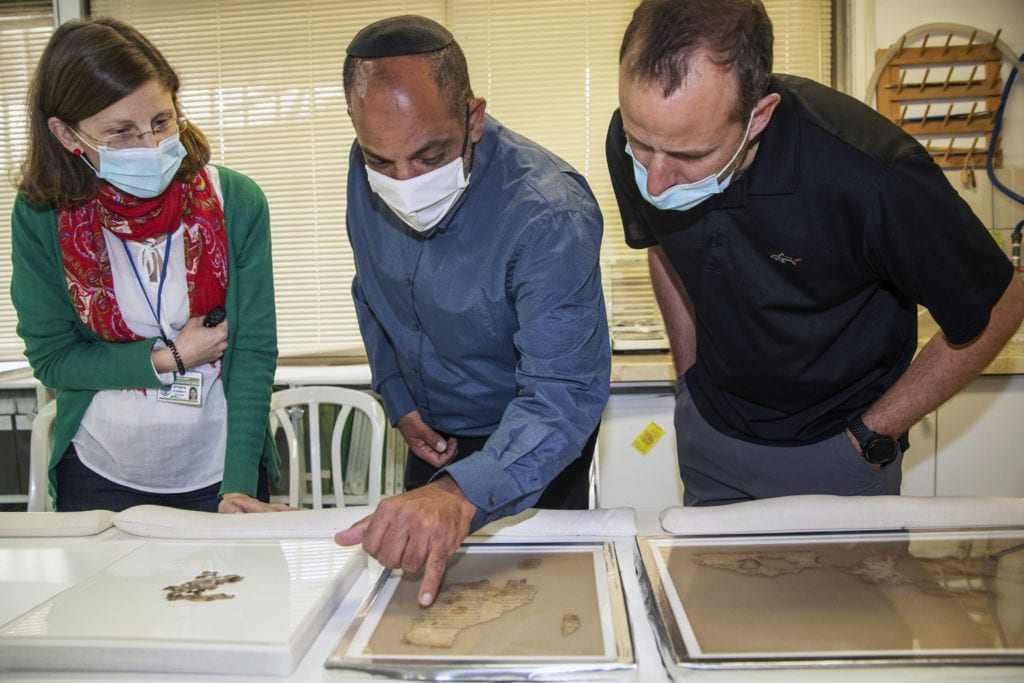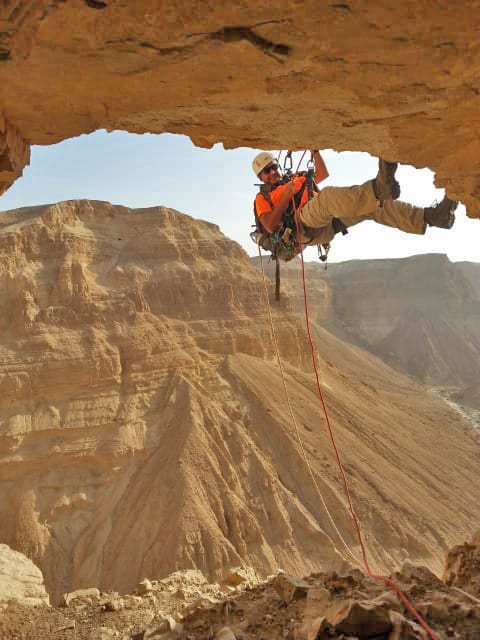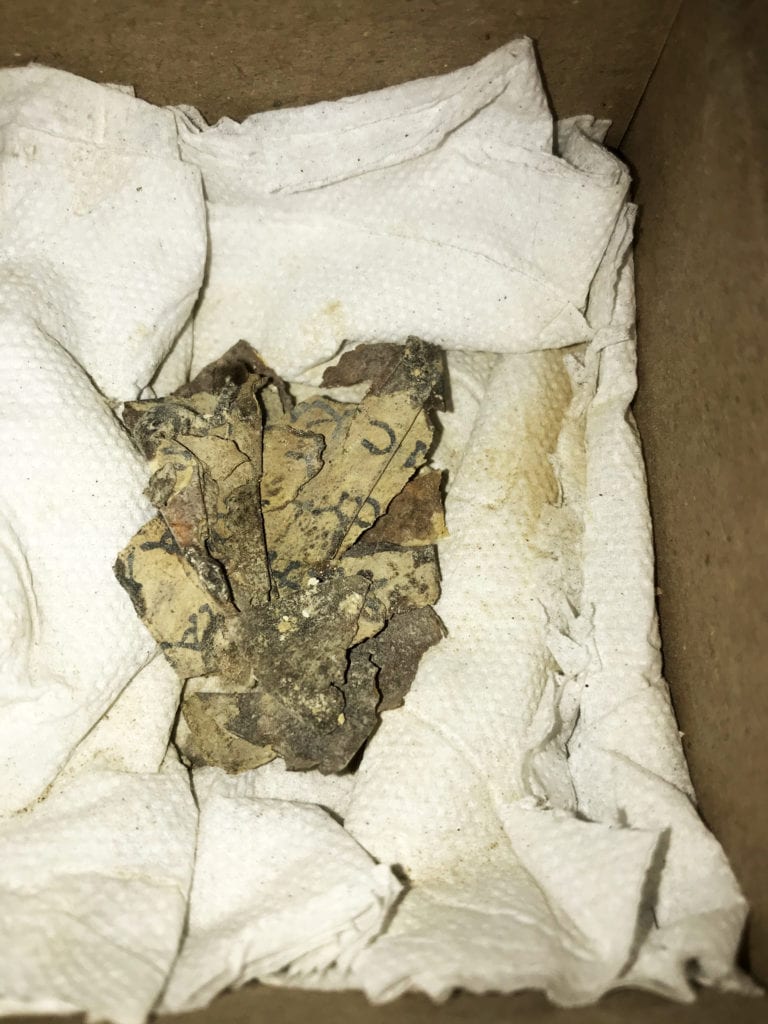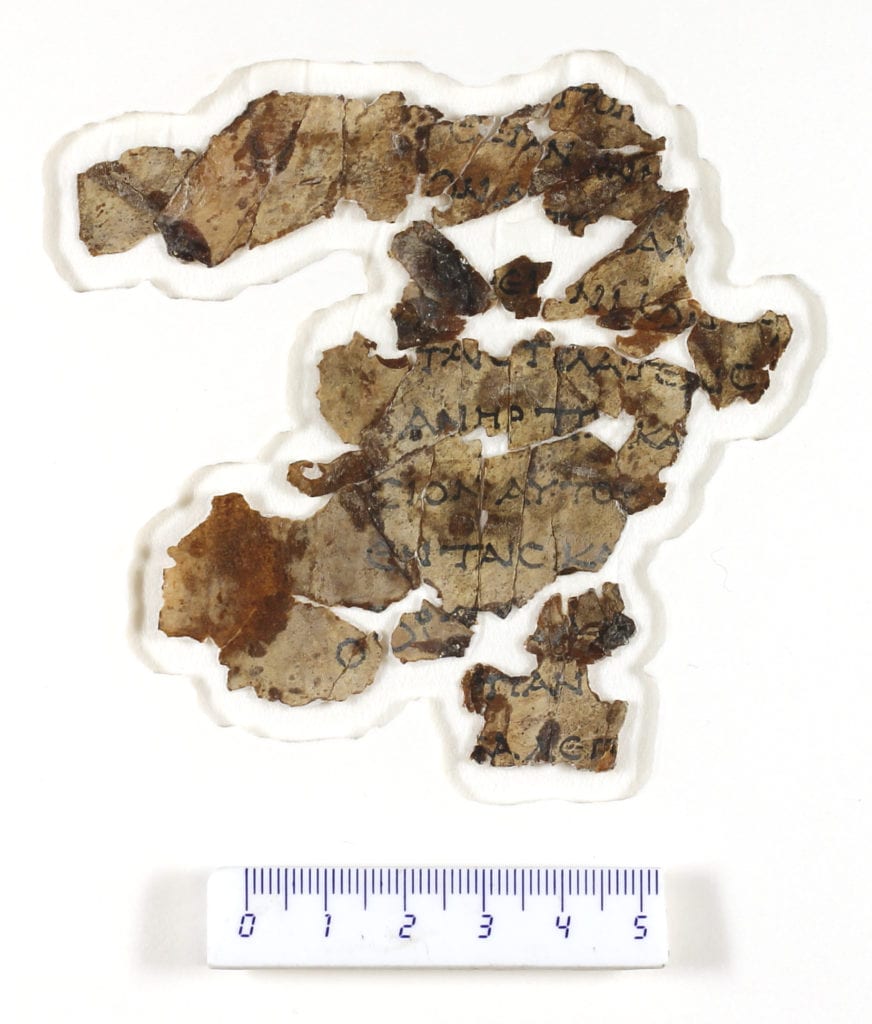
Recent Archaeological Announcement Reveals Secrets of the Prophets
For the first time in 60 years, archaeologists announced the recovery of ancient parchments adding to the Biblically significant trove of Dead Sea Scrolls.
Saving Biblical History from Antiquity Thieves
The parchments were part of an effort to save artifacts from antiquity theft, a growing problem in the region. Among the finds were a cache of rare coins from the days of Bar-Kokhba, a 6,000-year-old skeleton of a child – likely female, wrapped in a cloth and mummified, and a large complete basket dating back 10,500 years, likely the oldest in the world.
But for the Biblically-minded, the parchments were of intense interest. Israel365News interviewed the researchers, Tanya Bitler, Dr. Oren Ableman and Beatriz Riestra of the Dead Sea Scrolls Unit at the Israel Antiquities Authority, who focused on the parchments and asked several questions.

Right to Left: Raz Frohlich, CEO of the Ministry of Culture and Sports, Avi Cohen, the CEO of the Ministry of Jerusalem Affairs and Beatriz Riestra, researcher of the Dead Sea Scrolls at the Israel Antiquities Authority, beside the exposed scroll fragments. Photo: Shai Halevi, Israel Antiquities Authority
Cave of Horror
Though the artifacts came from many different sites, the parchments all came from a site called the Cave of Horror, officially cataloged as Cave 8, in the Judean Desert reserve’s Nahal Hever, so named because the skeletons of 40 men, women, and children were discovered inside when researcher first investigated the site in 1960. The skeletons were the remains of Jewish refugees from the Bar Kokhba revolt in 136 CE. At the top of the cliff were the ruins of a Roman camp used for the siege of the Jews hiding in the cave. The cave poses unique difficulties for the researchers as it is located roughly 80 meters below the cliff top, is flanked by gorges, and can only be reached by rappelling precariously down the sheer cliff.

Rappelling to the Cave of Horror. Photo: Eitan Klein, Israel Antiquities Authority
“More than 80 pieces of parchment were unearthed in the present excavation, of them, more than 40 are written or bear some ink remains, the researchers said. “The fragments are quite small, the biggest being nine centimeters square.”
The parchments were radiocarbon-dated back to the second century CE. A 1961 excavation of the cave found previous parchment fragments but none have been found since then. The recent find includes portions of the Book of the Twelve Minor Prophets written in Greek, including the books of Zechariah and Nahum. The verses were Greek translations of the Hebrew text. The name of God appears in ancient Hebrew script, known from the times of the First Temple in Jerusalem.
The verse from Nahum:
The mountains quake because of Him, And the hills melt. The earth heaves before Him, The world and all that dwell therein.Who can stand before His wrath? Who can resist His fury? His anger pours out like fire, And rocks are shattered because of Him. Nahum 1:5–6
The verse from Zechariah:
These are the things you are to do: Speak the truth to one another, render true and perfect justice in your gates. Zechariah 8:16
The researchers concluded that the parchments were written by two different scribes.

Sections of the Book of the Twelve Minor Prophets scroll discovered in the Judean Desert expedition as they were found. Photo: Ofer Sion, Israel Antiquities Authority
“The new fragments are part of a manuscript already known which was discovered in the 1950’s by antiquities looters and which is kept today by the Israel Antiquities Authority,” the researchers said. “Both the previously known fragments and the new ones are written by two different hands which differ in the size and style of the letters. While hand 1 is smaller is more ornamented (meaning it carries hooks and half-serifs), hand 2 is bigger and less ornamented. However, the overall general dimensions of the column blocks are similar in both hands, as is the character of the translation. Thus, both hands are considered to be part of one single manuscript and not two different scrolls.”
They also concluded that both scribes copied the text towards the end of the 1st century BCE and the fragments were part of a larger scroll.
“All of the newly discovered fragments belong to a manuscript known as ‘8HevXII gr’ or ‘the Greek Minor Prophets Scroll’,” they responded. “This is the largest Greek manuscript of the Dead Sea Scrolls.”
All of the fragments can be viewed on the Dead Sea Scrolls website.
Despite being written 1,900 years ago, there are precious few discrepancies.
“For the most part, the text is identical,” the researchers noted. “However, there are minor differences that can be found. Among the new fragments, the most notable textual difference is that at the end of Zechariah 8:16 there is the word ‘streets’ instead of the word ‘gates’ that appears in all other manuscripts.”
In an interview with Israel365, Rabbi Barnea Selavan noted that this small difference has much larger implications.
“The gates were where business was done,” Rabbi Selavan explained. “As a result, the courts were also at the gates in order to be on hand to adjudicate and disputes. Writing streets is very different.”

Part of the Book of the Twelve Minor Prophets scroll, written in Greek. Photo: Shai Halevi, Israel Antiquities Authority
Rabbi Selavan suggested that the scribe may have mistranslated the original text.
“The prophet Zechariah lived around 520 BCE,” Rabbi Selavan noted. “This means the parchment was written about 400 years after the prophet lived. This means the text was written close to the subject matter. It is like someone today writing about Napoleon.”
“This seems to indicate that perhaps the text of the Bible was a bit more fluid than it is today. Minor textual variations between manuscripts were not necessarily perceived as a problem.”
The method of writing the name of God was significant.
“The name of God, what we cal the Tetragrammaton, was written in the ancient Hebrew script. This script was rarely used even in Hebrew manuscripts at the time. However, the use of the ancient Hebrew script specifically for writing the names of God is well documented in several different manuscripts of the Dead Sea Scrolls. This phenomenon is also documented in some Greek fragments discovered in Egypt.”
They noted that it was not unusual for Jews to have Greek translations of the Biblical text.
“Greek was the international language of the time, much like English is today. As such, there were Jewish communities around the world that were primarily Greek-speaking. Most notable among these was the very large Jewish community of Egypt. In Judea, Jews tended to speak Hebrew and Aramaic, but many seem to have been familiar with Greek as well.”
Israel in the News